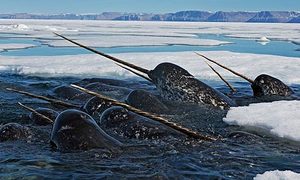
|
| ©Paul Nicken |
| The narhwal's spiral tusk has been likened to that of the mythical unicorn. |
Polar bears may get more attention - and later this week a
court-ordered decision by the US government will almost certainly see
them listed as a threatened species - but new research suggests the narwhal, the mysterious whale with a long spiral tusk, may be more at risk from climatic change. Researchers fear that the narwhal is so attuned to its environment, so narrow in its range of habitat and specific in diet, that it may be one of the least able of Arctic mammals to adapt to rapid warming in the high north.
Unlike the polar bear, which is widely distributed in the circumpolar region, the narwhal population is concentrated in a relatively small area between Baffin Island and Greenland. With a small population of no more than 80,000 individuals, narwhals stick closely to established migratory patterns and are more narrowly distributed than the two other Arctic whales, the bowhead and beluga.
Any change in the distribution of heavy winter pack ice is likely to adversely affect the whale, which feeds primarily in the cold and darkness of winter and can dive down in excess of 1,500 metres (5,000ft) in search of its favourite prey - the Greenland halibut - with a second-order preference for cod and squid.
"Narwhals are true Arctic specialists. They take very few species of prey. Unlike beluga, they won't just eat anything that comes along," says the study's lead author, research scientist Dr Kristin Laidre of the Polar Science Center at the University of Washington.
Unlike most whales, which are busy feeding in the summer, this gregarious and family-orientated mammal spends the warm months lazing in coastal along the north-east passage and on the westerly coast of Greenland.
"Things are becoming unpredictable for them," says Laidre. "Narwhals are regular in the habits, inflexible about where they spend their time, and tend to return to the same place year after year. We don't know exactly how they'll fare with less ice, but if it is lost, the temperature and currents change, that affects their prey and this will impact on the narwhal."
The loss of sea ice may make narwhal more vulnerable to killer whales which have in recent years ventured farther northwards with the ice retreat (killer whales tend to avoid water at or near freezing because they don't like to bump their unusually large dorsal fin against ice floes) but less to polar bears, which hunt narwhal in groups at the edge of the whales' breathing holes.
Inuit, which still harvest significant numbers of narwhal, report changes in their distribution and condition, while biologists with the Canadian Ice Service report a higher incidence of brucellosis, an early signifier of environmental stress.
In a climatic anomaly to the dramatic warming trends in the Arctic, researchers recently noticed that the narwhals' wintering grounds in Baffin Bay had been growing colder, leading to areas of open water vital for surfacing narwhal to breathe were freezing over.
During the last significant cooling period between the 12th and 19th centuries - the little ice age - narwhals are believed to have ranged farther south.
The last recorded sighting in British waters was in 1588, shortly before Queen Elizabeth I valued a horn, presented to her by privateer Martin Frobisher, at 10 times its weight in gold.
One recent study suggested the narwhals famous tusk is used by the whale as sensory antennae to better understand its surroundings. However, this is still a fringe belief.
"It's a sexual/social symbol - like the mane of a lion or antlers on stag," explains Laidre. "It's used for social dominance situations and in competition for females. They don't joust, they wave them gently, often with a female between them."
The Arctic mammal study, which was published in the journal Ecological Applications, acknowledges that the habits of the narwhal remain largely unknown because they are remote, hard to spot and hard to monitor. But is it likely the narwhal could surpass the polar bear as an icon of global warming vulnerability?
"Animals in the Arctic are affected in different ways. For polar bears, loss of ice is catastrophic. For narwhal, the effect of loss of ice is a little more difficult to grasp. There's so much to learn about the narwhal. There's so much we don't know. We see changes in the ecosystem, and we see narwhals in new areas, so there's definitely something going on."
The whale with the horn that once conferred divine protection to European monarchs, may soon be in need of divine protection itself.



Reader Comments
to our Newsletter